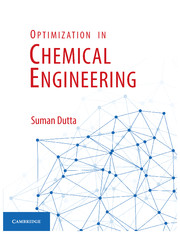Book contents
- Frontmatter
- Dedication
- Contents
- List of Figures
- List of Tables
- Preface
- 1 A Brief Discussion on Optimization
- 2 Formulation of Optimization Problems in Chemical and Biochemical Engineering
- 3 Single Variable Unconstrained Optimization Methods
- 4 Trust-Region Methods
- 5 Optimization of Unconstrained Multivariable Functions
- 6 Multivariable Optimization with Constraints
- 7 Optimization of Staged and Discrete Processes
- 8 Some Advanced Topics on Optimization
- 9 Nontraditional Optimization
- 10 Optimization of Various Chemical and Biochemical Processes
- 11 Statistical Optimization
- 12 Software Tools for Optimization Processes
- Multiple Choice Questions – 1
- Multiple Choice Questions – 2
- Multiple Choice Questions – 3
- Index
- References
8 - Some Advanced Topics on Optimization
Published online by Cambridge University Press: 05 February 2016
- Frontmatter
- Dedication
- Contents
- List of Figures
- List of Tables
- Preface
- 1 A Brief Discussion on Optimization
- 2 Formulation of Optimization Problems in Chemical and Biochemical Engineering
- 3 Single Variable Unconstrained Optimization Methods
- 4 Trust-Region Methods
- 5 Optimization of Unconstrained Multivariable Functions
- 6 Multivariable Optimization with Constraints
- 7 Optimization of Staged and Discrete Processes
- 8 Some Advanced Topics on Optimization
- 9 Nontraditional Optimization
- 10 Optimization of Various Chemical and Biochemical Processes
- 11 Statistical Optimization
- 12 Software Tools for Optimization Processes
- Multiple Choice Questions – 1
- Multiple Choice Questions – 2
- Multiple Choice Questions – 3
- Index
- References
Summary
Stochastic Optimization
Global optimization algorithms are categorized into two major classes: Deterministic and stochastic (Dixon et al. 1975). In some chemical engineering optimization problems, the model cannot be entirely specified because, it depends on quantities that are random or probabilistic at the time of formulation. For instance, uncertainty governs the prices of fuels, the availability of electricity, and the demand for chemicals in the market [N. V. Sahinidis, (2004)]. These ever-changing market conditions require a high flexibility for chemical process industries under various product specifications and various feedstocks. Furthermore, the properties of processes change themselves during process operation, e.g., tray efficiencies and fouling of the equipment (heat exchanger, catalytic reactor), which leads to a decrease of product quality with the same operating conditions [Henrion et al. (2001)]. For deterministic optimization methods, the expected values of uncertain variables are generally used. In real life application, the values of uncertain variables deviate from their expected values. When we are introducing a stochastic element within deterministic algorithms, the deterministic assurance that the global optimum can be determined is relaxed into a confidence measure. Stochastic methods can be utilized to evaluate the probability of obtaining the global minimum. Stochastic ideas are generally used to development the stopping criteria, or for the approximation of the regions of attraction as utilized by some methods [Arora et al. 1995].
Uncertainties in process industries
Uncertainty is a part of real systems; in reality, every phenomenon has a certain degree of uncertainty. During their operation, chemical processes are frequently faced with uncertain conditions. From the perspective of chemical process operation, there exist two types of uncertainties. These uncertainties can occur due to variation either in external parameters, such as fluctuation of inlet flow, temperature, pressure, composition of the feedstock, supply of utilities and other environment parameters, or in internal process parameters for example heat transfer coefficients, tray efficiency and reaction rate constants, etc. The optimization problems become much more complex due to the existence of uncertain parameters and have considerable implications on process feasibility and other quality measures for instance controllability, safety, and environmental compliance [Hou et al. (2000)]. Uncertainty also arises in the planning problem. Uncertainty in planning problems can be categorized into two groups: endogenous uncertainty and exogenous uncertainty.
Information
- Type
- Chapter
- Information
- Optimization in Chemical Engineering , pp. 180 - 221Publisher: Cambridge University PressPrint publication year: 2016
